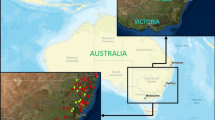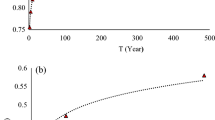Abstract
Wide field application of curve number (CN) methodology in design flood estimation and forecasting studies is a well-accepted reality. The parameter CN is often regarded as a constant, but it is in fact a random variable, for it relies on a number of factors governing the process of rainfall-runoff. This paper suggests an alternative procedure to estimate design runoff (Q) using design storm (P) and design curve number (CN) values. To this end, design CN values for different durations and return periods have been derived from 25 years of daily annual maximum P-Q data of 10 Indian catchments. When compared, the computed design Q from design CN values was either very close to or slightly greater than the observed Q. The performance is also evaluated using coefficient of determination (R2), percentage of bias (PBIAS), and normalized Nash-Sutcliffe efficiency (NNSE). The magnitude of design CN is found to decrease for longer durations and smaller return periods, and vice versa, and such a behavior invoked the development of an empirical relation for estimation of design CN from given return period and duration for gauged as well as ungauged watersheds. The statistical analysis revealed the general extreme value (GEV) to fit best the P-CN series, whereas multiple probability distributions, viz., GEV, Gumbel max, log Pearson 3, and Gen Pareto fitted best the Q series. The 50-year, 100-year, and 200-year runoff estimated from the P-CN series exceeded only marginally those derived from the conventional Q series approach.






Similar content being viewed by others
Data availability
Some or all data that support the findings of this study are available from the corresponding author upon reasonable request (rainfall and discharge data of 6 catchments of Godavari basin and 4 catchments of Mahanadi basin of India).
References
Alam MA, Emura K, Farnham C, Yuan J (2018) Best-fit probability distributions and return periods for maximum monthly rainfall in Bangladesh. Climate 6(1):9
Amrit K, Mishra SK, Pandey RP, Himanshu SK, Singh S (2019) Standardized precipitation index-based approach to predict environmental flow condition. Ecohydrology 12(7):e2127
Anil K (2000) Prediction of annual maximum daily rainfall of Ranichauri (Tehri Garhwal) based on probability analysis. Indian Journal of Soil Conservation 28(2):178–180
Bhakar SR, Iqbal M, Devanda M, Chhajed N, Bansal AK (2008) Probability analysis of rainfall at Kota. Indian Journal of Agricultural Research 42(3):201–206
Bonta JV (1997) Determination of watershed curve number using derived distributions. J Irrig Drain Eng 123(1):28–36
Farran MM, Elfeki AM (2020) Statistical analysis of NRCS curve number (NRCS-CN) in arid basins based on historical data. Arab J Geosci 13(1):1–15
Hawkins RH (1993) Asymptotic determination of runoff curve numbers from data. J Irrig Drain Eng 119(2):334–345
Hawkins RH (2001) Discussion of ‘Another look at SCS-CN method’ by SK Mishra and VP Singh. J Hydrol Eng 6:451–452
Hawkins RH, Hjelmfelt AT Jr, Zevenbergen AW (1985) Runoff probability, storm depth, and curve numbers. J Irrig Drain Eng 111(4):330–340
Hawkins RH, Ward TJ, Woodward DE, & Van Mullem JA (2008) Curve number hydrology: state of the practice. American Society of Civil Engineers
Hjelmfelt AT (1980) Empirical investigation of curve number technique. J Hydraul Div 106(9):1471–1476
Hjelmfelt AT Jr, Kramer KA, Burwell RE (1982) Curve numbers as random variables. Rainfall-runoff relationships. Water Resources Publications, Highlands Ranch, CO, pp 365–370
Kim NW, Shin MJ (2019) Curve Number estimation of ungauged catchments considering characteristics of rainfall and catchment. KSCE J of Civil Eng 23(4):1881–1890
Kim NW, Lee JW, Lee J, Lee JE (2010) SWAT application to estimate design runoff curve number for South Korean conditions. Hydrocarb Process 4(15):2156–2170
Kumar R, Chatterjee C (2005) Regional flood frequency analysis using L-moments for North Brahmaputra region of India. J Hydrol Eng 10(1):1–7
Kumar R, Chatterjee C, Kumar S, Lohani AK, Singh RD (2003) Development of regional flood frequency relationships using L-moments for Middle Ganga Plains Subzone 1 (f) of India. Water Res Manage 17(4):243–257
Lal M, Mishra SK, Pandey A (2015) Physical verification of the effect of land features and antecedent moisture on runoff curve number. Catena 133:318–327
Lal M, Mishra SK, Pandey A, Pandey RP, Meena PK, Chaudhary A, Kumar Y (2017) Evaluation of the Soil Conservation Service curve number methodology using data from agricultural plots. Hydrogeol J 25(1):151–167
Lian H, Yen H, Huang JC, Feng Q, Qin L, Bashir MA, Liu H (2020) CN-China: revised runoff curve number by using rainfall-runoff events data in China. Water Res 177:115767
Lim KJ, Engel BA, Tang Z, Choi J, Kim KS, Muthukrishnan S, Tripathy D (2005) Automated web GIS based hydrograph analysis tool, WHAT 1. J Ameri Water Res Associ 41(6):1407–1416
Mathwave (2013) EasyFit: distribution fitting made easy
McCuen RH (2002) Approach to confidence interval estimation for curve numbers. J Hydrol Eng 7(1):43–48
Mishra SK, Gajbhiye S, Pandey A (2013) Estimation of design runoff curve numbers for Narmada watersheds (India). J App Water Eng Res 1(1):69–79
NBSS&LUP, Staff. Soils of India. National Bureau of Soil Survey and Land Use Planning, Nagpur, India, NBSS Publ 94 (2002): 130.
NRCS (1997-2010). Hydrology. National Engineering Handbook, Supplement A, Section 4. Soil Conservation Service, USDA, Washington, DC
NRCS (2007) Estimation of direct runoff from storm rainfall. Chapter 10 In: National engineering handbook, V Mockus, AT Hjelmfelt, HF Moody, eds., US Department of Agriculture, Natural Resources Conservation Service, Washington, DC, 1-79
Okoli K, Breinl K, Mazzoleni M, Di Baldassarre G (2019) Design flood estimation: exploring the potentials and limitations of two alternative approaches. Water 11(4):729
Pai DS, Sridhar L, Rajeevan M, Sreejith OP, Satbhai NS, Mukhopadhyay B (2014) Development of a new high spatial resolution (0.25° X 0.25°) Long period (1901-2010) daily gridded rainfall data set over India and its comparison with existing data sets over the region. MAUSAM, 65 1(January 2014):1–18
Rallison RE (1980) Origin and evolution of the SCS runoff equation. Symposium on watershed management, ASCE, In, pp 912–924
Rezaie-balf M, Naganna SR, Ghaemi A, Deka PC (2017) Wavelet coupled MARS and M5 Model Tree approaches for groundwater level forecasting. J Hydrol 553:356–373
Roy PS, Meiyappan P, Joshi PK, Kale MP, Srivastav VK, Srivasatava SK, Behera MD, Roy A, Sharma Y, Ramachandran, R. M., Bhavani, P., Jain, A. K., & Krishnamurthy, Y. V. N., 2016. Decadal land use and land cover classifications across India, 1985, 1995, 2005. ORNL Distributed Active Archive Center. https://doi.org/10.3334/ORNLDAAC/1336
Sahu RK, Mishra SK, Eldho TI, Jain MK (2007) An advanced soil moisture accounting procedure for SCS curve number method. Hydrol Process 21(21):2872–2881
SCS (1956-1972) Hydrology. National Engineering Handbook, Section 4. Soil Conservation Service, USDA, Washington, DC
Singh RK (2001) Probability analysis for prediction of annual maximum rainfall of Eastern Himalaya (Sikkim mid hills). Ind J of Soil Conserv 29:263–265
Singh PK, Gaur ML, Mishra SK, Rawat SS (2010) An updated hydrological review on recent advancements in soil conservation service-curve number technique. J of Water and Clim Chang 1(2):118–134
Soulis KX, Valiantzas JD (2012) SCS-CN parameter determination using rainfall-runoff data in heterogeneous watersheds–the two-CN system approach. Hydrol Earth Syst Sci 16(3):1001–1015
Subramanya, K., 2013 Engineering Hydrology, 4e. Tata McGraw-Hill Education
Walega A, Amatya DM, Caldwell P, Marion D, Panda S (2020) Assessment of storm direct runoff and peak flow rates using improved SCS-CN models for selected forested watersheds in the Southeastern United States. J of Hydrol: Reg Studi 27:100645
Williams JR, & LaSeur WV (1976) Water yield model using SCS curve numbers. J of the Hydraul Divi 102(ASCE# 12379)
Acknowledgements
The authors wish to thank the Indian Institute of Technology Roorkee for providing the requisite space and resources during the study. We extend our sincere gratitude to IMD and India WRIS for providing open-access data. We are also grateful to the editor and anonymous reviewers, whose suggestions were very helpful in significantly improving the initial version of the manuscript.
Code availability
Not applicable
Author information
Authors and Affiliations
Corresponding author
Ethics declarations
Conflict of interest
The authors declare no competing interests.
Additional information
Responsible Editor: Broder J. Merkel
Rights and permissions
About this article
Cite this article
Sharma, I., Mishra, S.K. & Pandey, A. A simple procedure for design flood estimation incorporating duration and return period of design rainfall. Arab J Geosci 14, 1286 (2021). https://doi.org/10.1007/s12517-021-07645-8
Received:
Accepted:
Published:
DOI: https://doi.org/10.1007/s12517-021-07645-8




